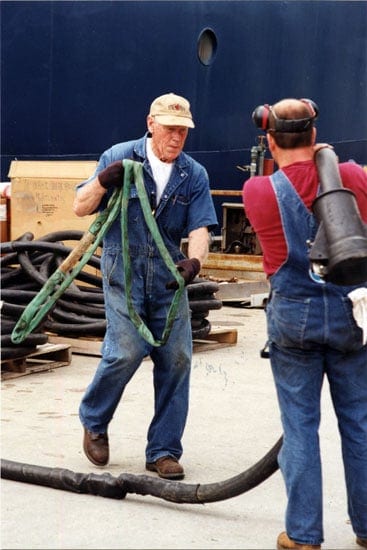Richard S. “Dick” Edwards
The Woods Hole Oceanographic Institution announces with great sorrow the death of Richard S. “Dick” Edwards on October 30, 2007, at JML Care Center from the effects of a stroke. He was 85.
One evening in 1947, with the promise of a summer job at WHOI, Dick Edwards rode a bus from New York City–where he was a physics student at Columbia University–to Woods Hole. He found his way to the institution’s buildings on Water Street, and the guard on duty took him to the shop facility on the ground floor of Bigelow Laboratory. There he found Allyn Vine, Joe Worzel, and Gordon Hamilton preparing an instrument for installation on a submarine the next morning in New London, Conn. Being, as he described himself, “pretty handy,” Dick rolled up his sleeves and immediately joined the all-night effort. Except for three years when he studied geophysics under Maurice Ewing at Columbia and a four-year Navy recall for the Korean War (he had already served from 1941 to 1946), Dick spent the rest of his working life at WHOI, always known for pitching in wherever he could help. His WHOI employee number was 12.
During his World War II and Korean War service in the Navy, Dick became an expert in explosives, with mine disposal as a specialty. In Korea, he served for 1 1/2 years as Ordnance Disposal and Intelligence Officer aboard a minesweeper, and he was later put in command of the USS Medrick for its return from Japanese waters to the U.S. He was part of a demolition team that was the forerunner of Navy SEALS. He received several medals for his service, including the Legion of Merit with Combat “V” and the Distinguished Service Cross by the British Embassy in Washington, DC. For the latter award, he was cited for leading a group that destroyed more than 350 mines in various Korean harbors and for personally disarming nearly 20 more (including several extremely dangerous Russian mines and others of previously unknown construction). “When taken under fire on numerous occasions by enemy small arms and shore batteries, he demonstrated cool courage, daring skill, and exceptional leadership by completing his mission without damage or casualties. By his sound judgment, exceptional professional and technical skill, and conscientious devotion to the fulfillment of an important task, he contributed immeasurably to the successful conduct of minesweeping operations against the enemy.”
In his early career at WHOI, Dick applied his knowledge of explosives to the seismic work of groups led first by Maurice Ewing (who later founded the Lamont-Doherty Geological Observatory) and later by Brackett Hersey. Navy officials continued to call on his explosives expertise for many years, and in the early 1990s, he managed the final disposal of unexploded ordnance lingering on Nonamessett Island in Woods Hole harbor, where the WHOI explosives research group known as Navy 7 conducted much of its research during WWII.
Dick enjoyed going to sea, and he particularly relished an early two-ship seismic survey during the summer of 1950 with the first Atlantis and Caryn. In those days, the sound sources were explosives launched from an Atlantis whaleboat. In 1953, while still part of the Navy Reserve, he received a letter from WHOI indicating that he was a candidate for skipper of Atlantis. Although he very much wanted to be a permanent employee at WHOI, he declined the candidacy in hopes of continuing his education at Columbia when he was released from his military service.
When the U.S. Navy assigned the former deep-sea salvage and rescue tug Chain to Woods Hole in 1957the Institution’s first large research vessel–Dick went to the yard to supervise conversion of the ship for science, thus beginning his transition to marine operations. Dick served as WHOI’s marine superintendent from 1960 until his “official” retirement in 1988, taking responsibility for the day-to-day logistics of keeping a fleet running. He chaired the ship design committee for Atlantis II in the early 1960s, was involved with Alvin’s recovery after the sub sank in 1966. He was devoted to all the tasks of running a healthy research fleetincluding being there to cast off or catch the lines for countless departures and arrivals, in all weather and at any time of the day or night. He was known for an uncanny ability to anticipate and avert problems on the WHOI pier.
After retirement, Dick served for many years in a casual position as port captain, while also doing volunteer work for the WHOI Archives. In 1990 Dick received WHOI’s Vetlesen Award, “given in recognition of exceptional performance on behalf of his colleagues for maintaining and encouraging the WHOI community spirit.”
He had a great tenor voice and sang with a barbershop quartet in the “WHOI Follies” of 1961. He enjoyed jazz, and he was a long-time second tenor with the Greater Falmouth Mostly All Male Men’s Chorus.
Dick and Anne Edwards were married in 1977. Their family includes five children, eleven grandchildren, and five great grandchildren. There will be a memorial gathering next summer, and Dick’s ashes will be scattered at sea. In lieu of flowers, please consider donations to Penikese Island School.

